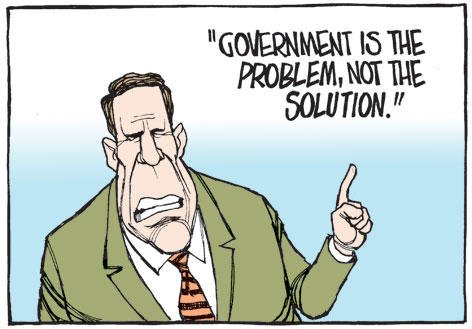Towards Voluntaryism (Part 27)
3.10. Government: Removing Corrupt & Incompetent Public Servants via Recall
Towards Voluntaryism (Part 27)
Removing Corrupt & Incompetent Public Servants via Recall
Public servants that oppose reforming the functionality and accountability of their offices by the general public have lost sight of their obligation to serve the public. Currently, public servants of all ilks (though by no means every public servant) view the general public as chattel that must obey the dictates of a government that demonstrates a reckless disregard for individual rights and the founding documents of the United States.
If any of the legislative reform postulated previously, designed to eliminate corruption, eliminate the ability of public servants to unethically profit from their office and to hold public servants accountable to their constituencies is to succeed, the public needs to know how to recall (i.e. remove from office) public servants that will not heed the will of the people. In the event there is demonstrable criminal action or abuse of power on the part of a public servant, it is also useful for the public to know how to impeach a public servant.
I believe that the current rampant corruption of public office exists primarily because most people have been raised to ignorance and obedience and are lost in the bread and games spectacles of media manipulation. I contend that the means of impeaching and recalling corrupt, incompetent public servants is intentionally kept difficult so as to ensure that the special interests' corruption and purchase of public servants can proceed largely unimpeded. Indeed, in many states it is simply not possible.
Nevertheless, if there is any hope of restoring the constitutional republic of the United States and moving towards Voluntaryism from there, the public needs to defend itself by using the tools of governance to control what is increasingly an unaccountable, entrenched and bureaucratic cesspool of corrupt coercive collectivists.
The following briefly presents what impeachments and recalls are, the principles of their enactment and provides a list of resources that can assist those who wish to remove public servants from office.
Recall vs. Impeachment
A recall and an impeachment are two different tactics that are generally intended to remove a public official from office. There is however a difference.
A recall is a political device used to remove public servants from office. Recalls are most common at the local level (municipal government, city councils, school boards etc.). They are also possible at the state level. As a political device, in many states recalls can be initiated against public servants due to general dissatisfaction of the electorate. In some states, there must be specific grounds for initiating a recall, which will be presented below.
Some states can recall their state representatives to the House of Representatives and the Senate, but not all. The United States Supreme Court has not yet been forced to determine if it is possible to recall federal officials. In U.S. Term Limits, Inc. v Thornton, the SCOTUS did however rule that states cannot impose "new terms, qualifications or conditions of service on federal officials." source By all appearances however, state and federal courts are seeking to limit the ability of disgruntled and politically active citizens to recall federal public servants.
In contrast to a recall, impeachment is a legal process that includes the filing of charges and a trial to determine guilt. Impeachment requires a state house to bring charges (which can be motivated by an active citizenry) and the Senate to act as a jury. This may or may not result in the removal of a public servant from office, even if the public servant is found guilty of a crime.
In the following, the focus will be on understanding how to recall public servants.
What Are The General Steps of A Recall?
There is a general series of steps that apply throughout the country to initiate and execute a recall movement. The details differ from one state to the next, but generally speaking, the steps are:
- File an application to circulate a recall petition (some states allow petitions only if they meet certain grounds for recall).
- Circulate a recall petition, gathering a specified number of signatures in a limited period of time (view the detailed petitioning requirements).
- Submit petitions to election officials for verification of signatures.
- If sufficient valid signatures are presented, a recall election is held.
Where Are Recalls Possible?
Recalls are possible in 36 states. The ability to recall ranges from local officials to state officials, all or only elected or a selection of public servants. Generally speaking, the ability to recall officials at the municipal or local level is more widely possible, see Recall of Local Officials - scroll down to locate. Contact your city hall for information about your local jurisdiction.
The following map details where recalls are possible for state public servants and at what level:
image source - visit for interactive map
Public Servants That Can Be Recalled
Recalls can target members of all three branches of government in many states: executive, legislative and judicial. In many others, only members of certain branches or specific offices can be recalled. The following chart provides an overview of states where recalls are possible and which public servants can be recalled.
image source - visit for hyperlinks to source materials
Ground Required for A Recall by State
Many states allow recalls strictly as a political device. Others require a certain criteria to be met for a recall to be permissible. The following chart details those state where certain grounds must be met:
image source - visit for hyperlinks to source materials
Provisions for Recalling Public Servants by State
Recalls universally have a set of provisions that must be fulfilled for state public servants to be recalled. For the provisions for local or municipal public servants, contact your local city hall. Generally speaking, a certain percentage of votes cast for the public servant's office in the last election must be reached within a limited time ranging from 60 to 320 days. The following chart provides a list of specific provisions.
image source - visit for hyperlinks to source materials
Conclusion
As indicated above and in keeping with the strategy being developed throughout the series Towards Voluntaryism, information as to how to initiate a recall process is included as part of the toolbox necessary to combat corruption and restore accountability to government.
For further information and more details about your state or jurisdiction, visit the following sources, which served as the foundation for this post:
Ballotpedia.org
NCSL - National Conference of State Legislatures
...
Next: Towards Voluntaryism (Part 28) - Using Citizen's Arrests to Combat Corruption

.
.
.
Shot with a golden arrow,
Cupid Zero
.
I consider requests to write on a topic of your choice.
.
Don't forget to upvote, follow and resteem! Comments always appreciated.
.
.
.
.
.
.
.
.
.
.
.
.
.
If you aren't on Steemit, please consider supporting my work with a gift of:
Bitcoin: 1fruAGn9JcKqJJscreUpS2XurfLzksBe8
Litecoin: LQf19ExcdSFDjYj6NktRgzBnJ7NScVgikA
Ethereum: 0xEe3005b1D2D8963a85E1Ca4ff511acCd98A1E29D



Curated for #informationwar (by @truthforce)